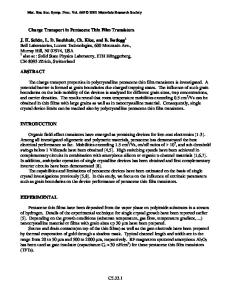Thin Film Transistors with Layered a-Si:H Structure
- PDF / 340,954 Bytes
- 6 Pages / 414.72 x 648 pts Page_size
- 79 Downloads / 326 Views
Mat. Res. Soc. Symp. Proc. Vol. 377 ©1995 Materials Research Society
ouu.(It
n+
a-Si:H Gate Dielectric
Gate I
i
FIGURE 1 CROSS SECTION OF TFT with n-Layer a-Si:H
1.0
xlO-3 0.8
0.6 S,,
0.4 0.2 0.0
0
5
10
V (v)
15
20
Figure 2 t1l/2 v. Vg of Single a-Sr.H TF's with Different a-Si:H Deposition Powers
702
information can be found in ref. 9. The SiNx/a-Si:H/SiNx films anr deposited with a multichamber system (Ulvac model 7433) at 250°C. The SiNx film was deposited from SiH 4 /NH 3 /N2 at 500 mTorr and 300 W. The relations between the gate SiNx film process and the TFT performance are discussed in ref. 8. All layers in the TFTs are the same except a-Si:H. For the single a-Si:H TFT, the a-Si:H film was deposited from SiH 4 at 250 mTorr, and 85 W. For the layered a-Si:H TFTs, as shown in Fig. 1, the a-.Si:H films were deposited with the same gas flow and pressure except the power. For example, for the 3-layer a-Si:H, the powers are 85/120/85W or 85/150/85W. For the 5-layer a-Si:H, the power is 85/120/85/120/85W. The a-Si:H deposition conditions at the two interfaces, i.e., at the gate dielectric and at the top channel passivation, are the same in all experiments. The first interface a-Si:H thickness is about 180A and the second interface thickness is about 90A. The field effect mobility and threshold voltage are determined from the Id 1/ 2 vs. Vg curve. The a-Si:H layer was profiled and characterized with SIMS, RBS, and TEM. The hydrogen plasma exposed SiNx surface was analyzed with ESCA. Results and Discussion Figure 2 shows Id 1/ 2 vs. Vg curves of three single a-Si:I-l layer TFTs. The a-Si:H deposition power varies from 85 to 150W. The mobility decreases and the threshold voltage increases with the increase of power. Since all three transistors have the same gate dielectric film, the deteriorating of the transistor characteristics with the increase of power can be contributed to the deterioration of the interface at a-Si:H and gate SiNx. Figure '3 shows the peak-to-peak voltage Vpp of the Sill4 plasma vs. the plasma power. The plasma potential qualitatively increases with the increase of Vpp. This, in combination with the increase of hydrogen concentration with power, can cause serious surface damage of the gate SiNx.(10). For example, ESCA spectra of a SiNx surface before and after exposure to hydrogen plasma are different. After hydrogen exposure, ratios of Si-O and SiO(N) to Si-N increase. This indicates that hydrogen attacks the SiNx film by breaking the Si-N bond and by forming silicon dangling bonds. When aSi:H is deposited on top of the damaged film, the interfacial density of states is high. Therefore, the mobility is lower and the threshold voltage is higher. Figure 4 shows the Idl/ 2 vs. Vg curves of TFTs with a-Si:H composed of single, 3, and 5 layers of layers. Each TFT has an Ion greater than 10- 6 Amp and an 'off lower than 10-1 2 Amp. The deposition condition of the gate interface a-Si:H layer is the same in these transistors. If transistor characteristics are controlled only by the in
Data Loading...










